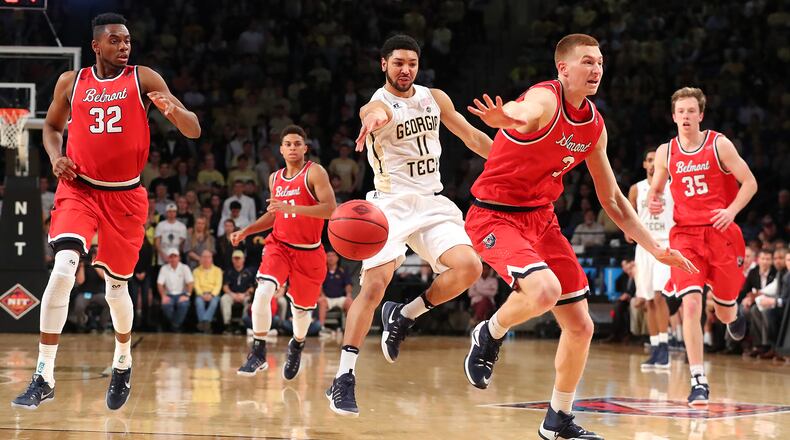Georgia Tech coach Josh Pastner doesn’t hesitate to bring up the offensive limitations of his team. He did it Tuesday night following the Yellow Jackets’ NIT quarterfinal win over Ole Miss.
But, in their three-game NIT run, the Jackets look more and more like a team that has a pretty good idea of what it’s supposed to do and is capable of doing it.
Against the Rebels, Tech shot 51.9 percent, its highest rate of the season against a power-conference opponent.
“We allowed them to have 21 assists on 27 made field goals, which would tell you their ball movement was excellent,” Ole Miss coach Andy Kennedy said, “and at the end of that ball movement, they were making shots.”
In the three NIT games, against Indiana, Belmont and Ole Miss, Tech has cleared the 70-point barrier in each, the first time the Jackets have strung three 70-plus games in a row. It’s a considerable achievement for a team that, in 19 ACC games (regular season plus one tournament game), reached 70 points only five times. Four other instances, the Jackets couldn’t crack 60.
“I think the team is jelling at the right time,” guard Josh Okogie, who put up a game-high 26 points on the Rebels. “Coach (Pastner) always says we’re a good team. We’re on the stretch to becoming a great team. I think right now, we’re just being a great team.”
The quality of the defenses bears considering. Indiana, Belmont and Ole Miss rank between 99th and 130th in KenPom’s adjusted defensive efficiency rankings. Eight of Tech’s ACC opponents rank higher.
Still, Tech is making shots it has missed in the past. When Ole Miss cut Tech’s deficit to six points at the 15:38 mark of the second half, the Jackets had lost momentum and needed a boost. Guard Corey Heyward found forward Quinton Stephens, who let go of a 3-point shot from the corner. Stephens entered the game a 31.8 percent shooter from 3-point range, hardly a marksman. He has had an up-and-down career in which he has been willing to take big shots, but not always able to make them.
Stephens’ shot found net and started an 11-3 run that kept Ole Miss at arm’s length.
“They just went silent,” said Stephens of the Ole Miss fans, who had been serenading him with the dreaded “Airball” chant. “That was probably my favorite part of the night.”
In three NIT games, Stephens is averaging 16.3 points per game and is shooting 60.6 percent from the field.
“Q’s been playing the best basketball of his career,” Pastner said.
Against Belmont, Okogie drove in for a layup and was bumped midair. Okogie kept his eye on the goal and, his back facing the basket, tossed the ball off the glass for the basket. He was similarly effective in finishing through contact against Ole Miss in scoring his game-high 26 points.
One of Tech’s torments — layups that bounced around the rim and fell out — kept falling through the basket against Ole Miss.
Center Ben Lammers has had a resurgence, as well. Perhaps worn down by his playing-time load, he had three of his poorest shooting games (1-for-9 against N.C. State, 4-for-11 against Notre Dame and 3-for-9 against Pittsburgh) in the final weeks of the season. In three NIT games, he’s 18-for-28, aided by effective guard play, setting him up for easy baskets but also the return of his jump shot.
“Really impressed with Ben Lammers, really impressed with Josh Okogie,” Kennedy said.
In the three NIT games, Tech has shot 48.8 percent from the field and has a 2.0 assist/turnover ratio. In the Jackets’ 18 ACC regular-season games, they shot 43.4 from the field and had a 1.1 assist/turnover ratio.
“I just think we’re playing free,” Stephens said. “We’re in rhythm now. We’re playing our best basketball now. We know what works for us. We’ve had — what — 21 straight games of just high-level teams, and we’re able to make adjustments, and we’re just being aggressive.”
Part of Tech’s basket-scoring success in the NIT after getting ground down to its nubs in the ACC is likely that teams don’t have familiarity with the Jackets’ cutting and ball movement and have little time to prepare for it. Against the five ACC teams that the Jackets played twice, Tech’s field-goal percentage was lower in each of the five rematches, losing all five after winning the first game all five times.
A little extra rest — the Jackets had a week from their ACC Tournament loss until the first NIT game, and then five days until the second-round game against Clemson — has helped, too. Active defense has also produced more open-court scoring chances. Tech had 11 steals against both Belmont and Ole Miss; the Jackets hadn’t had a double-digit steal game since the ACC opener against North Carolina.
Tech is still doing it through the scheme. Pastner loves ball movement that creates assisted baskets and has been delighted that of Tech’s 80 baskets in NIT play, 61 have been assisted.
Whatever the reason, the offense is functioning better. The scoreboard says as much.
About the Author
Keep Reading
The Latest
Featured




